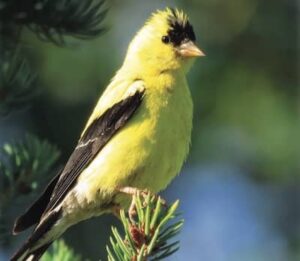
Spring is the time to watch as our feathered friends slowly reappear from their fantastic migratory flights, some coming from thousands of kilometres away to make the foothills their summer home; others are just passing through on their way even further north. I love that each day seems to add a new birdsong or raptor cry, heralding their survival from the arduous journeys. Spring doesn’t seem complete until I hear that one familiar call close to mid-May of “I swear I just saw a wild canary”. If you’ve lived out here awhile you will most likely be acquainted with the bright yellow male American Goldfinches that cause such a stir when spotted by those unfamiliar.
These flamboyantly dressed males sport a black cap on their heads and black wings and tail elegantly trimmed with white. The females share the black wings and tail, but appear more of a dull yellowish-grey and have no cap. The males will molt to look like the females at the end of summer. But why are the goldfinches one of the later migratory arrivals? Although the males do have to molt into their brilliant Spring plumage, the real reason has more to do with their diet. Goldfinches are a songbird that are mostly granivorous (feeding on grain) relying on seeds, particularly from thistles. There isn’t much point in arriving early to compete for nesting sites if there is not enough food available to feed your nestlings (baby birds). As such, it is easier to spot the goldfinches because not only are they so brightly coloured, but they are usually still hanging out in flocks until they start breeding in the Summer after the thistles have flowered.
It is hard to say why the flocks of goldfinches bring such joy; personally, I found a kindred spirit who can appreciate weeds like dandelions. Others may like that their sunny disposition seems to match their radiant yellow attire. Native American stories tell of the Goldfinch acting out of kindness and usually being rewarded by being gifted with the colour of the sun, and then being so overcome with joy they start to sing their sweet little melody of “per- chick-o-ree”. Some people describe the American goldfinch song as “potato chip” but I have yet to hear any goldfinch say it, perhaps I have only come across more health-conscious birds.
What would life be like if we embraced our own inner goldfinch? When faced with weeds on our journey, could we see them as an opportunity to socialize and gather food, could we choose our time to shine and then be content to be unnoticed in the background like the males who molt twice a year? Would it not be grand to lift others up by showing up and singing a cheery song at the end of a long winter?
If you would like to learn ways to help your feathered neighbours like the goldfinch as they migrate visit birdfriendlycalgary.ca/ as we share many of the same native species as Calgary or come check out Nature Canada’s Migratory Bird Day (May 13th) at Telus Spark. Details can be found at the bird friendly website.

























